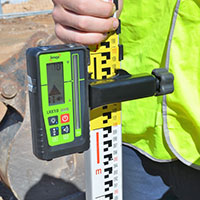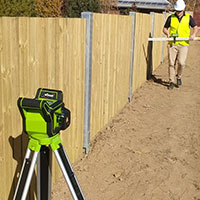A Guide to Rotary Laser Levels
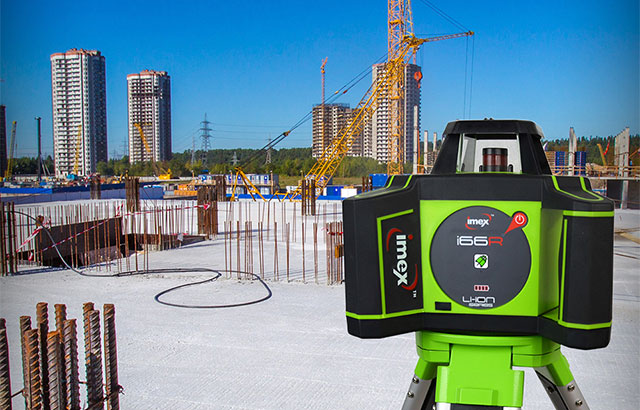
This rotary laser levels on the construction site guide investigates the various types of site construction rotary laser levels available, the features and benefits they offer and what applications they are used for.
In this guide we will establish:
- What is a rotary laser level?
- Do I need to use a laser receiver and how do they work?
- Rotary lasers with horizontal or vertical levelling?
- What is the difference between red and green rotary laser levels?
- Rotary laser levels functions
- Which rotary laser level should I choose?
- Which rotary laser level suits my specific application?
- The verdict
What is a rotary laser level?
A rotary laser level is an instrument that spins a beam of light fast enough to create a complete 360 degree horizontal or vertical plane.
They can be used internally for fit-out projects or externally, with a laser receiver and staff, for groundworks – i.e. digging down or building up. Although there can be a crossover when it comes to indoor and outdoor use, static line lasers are generally used internally, whereas rotary lasers with receivers, tend to be more commonly used outside.
Do I need to use a laser receiver?
If you are working externally, a receiver – also known as a detector or ‘rod eye’ – will be required as the laser beam will not be visible in daylight. For internal applications, it depends on the size of the room or area you are working in – as well as how ‘bright’ it is.
A general rule of thumb is; for distances up to 20M, you should be able to clearly see the laser line. Over 20M will almost certainly require a laser detector. As rotary lasers are predominantly used for outside applications, a laser receiver will generally be included in the box.
How do the rotary laser and receiver work together?
The rotary laser level projects a beam that can be detected by a receiver. Not all receivers are the same, so it’s important to check compatibility when replacing lost or broken ones. Receivers are mounted to a staff and have ‘pick-up’ window and internal electronics, that indicate the centre of the laser line to the operator. Visual indicators and audible sounds ensure a level reading can be achieved by a single operator, as well as making comparisons between different points on the terrain.
Rotary lasers with horizontal or vertical levelling?
All reputable rotary lasers levels have a horizontal self-levelling facility. Once the laser starts up, it will eventually give a true level line by itself. It will also stop if knocked or disturbed, meaning you cannot get any inaccuracies during use. The more expensive units also offer a vertical function for tasks such as frame levelling, steelwork or plumb requirements.
What is the difference between red and green rotary laser levels?
There has been a significant shift towards green beam lasers in the last few years. Although the accuracy of both red and green beam lasers are the same, it’s the visibility of a green beam that makes it a desirable choice. The green line appears brighter to the human eye, and often produces a crisper line. The downside of green lasers is they cost more, due to the component parts of a green diode being more expensive.
If the laser is going to be used regularly for internal work, green is the way to go – budget allowing. If the levelling tasks are predominantly going to be outside, there’s no need to invest in a green unit as neither red nor green lines will be visible in daylight conditions anyway.
Rotary laser levels with grading function? Single or dual grade?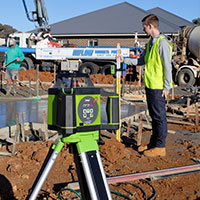
The high-end rotary laser levels may also enable grading – single or dual. This is perfect for water drainage applications, with single grading allowing for slopes on one axis and dual grading allowing for slopes on two axis – to give a compound grade.
You can achieve dual slope capability with a single grade laser level, but the laser will need to be set-up twice; x-axis followed by y-axis. If compound grades are a regular requirement, it’s definitely worth the extra investment in a dual grade laser.
Rotary laser levels with scan mode?
The final significant feature that can be found on superior rotating construction laser levels is ‘scan mode’. This clever facility allows for part beam rotation in a selected working area. By narrowing the angle of the laser, the beam can become more concentrated and more visible to the human eye. It’s also useful on busy work sites, where you can limit laser ‘exposure’ to your specific working area and avoid other potential laser interference.
Which rotary laser level should I choose?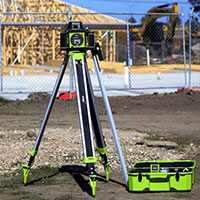
For this part of the rotary laser level guide, I have compared the latest Imex i-Series range of rotating laser levels. Since 2006, Imex has become a leader in the construction laser market for the discerning trade professionals. As with most premium brands, the Imex construction lasers are available in two formats:
- Laser & Receiver – supplied in a robust carry case with USB charger, car charger, 2 x 9.0Ah lithium-ion batteries and target plate.
- Laser & Receiver Kit – also supplied in a robust carry case with USB charger, car charger, 2 x 9.0Ah lithium-ion batteries and target plate – plus 5 metre levelling staff and heavy duty aluminium construction tripod.
With most levelling staffs and construction tripods being universal in size and fitting, you can utilise existing items you may already have by going for format 1. The second format has identical contents in the box, but the staff and tripod are also included with the kit.
The comparison table below clearly identifies the attributes of each Imex rotary laser level. For those that are familiar with the popular Leica Rugby construction lasers, the table also highlights the direct comparable Leica Rugby equivalents, when it comes to features and benefits.
| Features | i66R | i77R | i88R | i88G |
| Single person operation | Yes | Yes | Yes | Yes |
| Range (diameter) | 400m | 600m | 600m | 600m |
| Accuracy at 30m | 2mm | 1.5mm | 1.5mm | 1.5mm |
| Green or red beam | Red | Red | Red | Green |
| Self levelling | Yes | Yes | Yes | Yes |
| Interior & exterior use | Interior & exterior | Interior & exterior | Interior & exterior | Interior & exterior |
| Horizontal & vertical | Horizontal only | Horizontal only | Horizontal & vertical | Horizontal & vertical |
| Grading function | No grading | Single grade | Dual grade | Dual grade |
| Scan mode | No | No | Yes | Yes |
| Can be used with receiver | Yes | Yes | Yes | Yes |
| IP Rating | IP66 | IP66 | IP66 | IP66 |
| Remote control unit | No | Yes | Yes | Yes |
| Leica Rugby equivalent | Rugby 610 | Rugby 620 | Rugby 640 | Rugby 640G |
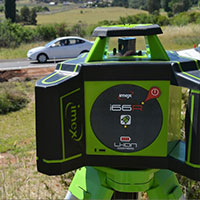
The entire i-Series range is supplied with two 9.0Ah lithium-ion batteries that can be charged directly with either a 240V mains supply USB cable or 12V in-car charger. The fact that they can be charged separately to the actual laser unit, means the operator can get on with the job using one battery, whilst the spare is being charged.
The i-Series range is also backed-up with an impressive five years warranty, largely thanks to the incredibly robust casings that house the precision components inside. Every laser level is supplied with a calibration certificate in the box, guaranteeing accuracy from the moment you start using it.
Which rotary laser level suits my specific application?
For this part of the article, I have once again referred to the Imex i-Series range. The comparison table below clearly identifies the perfect applications for each model.
Key: ✔ = suitable ✔✔ = ideal application ✔✔✔ = perfect application
| Application | i66R | i77R | i88R | i88G |
| General survey & setout | ✔✔ | ✔✔ | ✔✔✔ | ✔✔✔ |
| Site preparation | ✔✔ | ✔✔✔ | ✔✔ | ✔✔ |
| Water drainage | ✔ | ✔✔ | ✔✔✔ | ✔✔✔ |
| Slab layout | ✔ | ✔✔ | ✔✔✔ | ✔✔✔ |
| Steelwork & plumb | ✔✔✔ | ✔✔✔ | ||
| Interior setout | ✔✔ | ✔✔✔ | ||
| Kitchen & cabinetry | ✔ | ✔✔ | ||
| Walls & flooring | ✔ | ✔✔ | ||
| Suspended ceilings | ✔ | ✔ | ✔✔ | ✔✔✔ |
| Interior lighting setout | ✔ | ✔✔ | ||
| Warehouse fit-out | ✔ | ✔✔ | ✔✔✔ | |
| Driveways & paving | ✔ | ✔✔✔ | ✔✔✔ |
The Verdict: which is the best rotary construction laser level?
Truth be told; it doesn’t matter which Imex i-Series laser you go for as every model is manufactured to exacting ISO9001 standards and their design team has developed an excellent line-up of site construction lasers, that are comparable to the market leading Leica Rugby range as well as other premium brands including Topcon, Hilti, Spectra and PLS. My recommendation would be to refer to the application table and simply check exactly which tasks you intend to carry out. There’s no point investing in features you’ll never utilise, plus extra buttons on the laser can overcomplicate things. 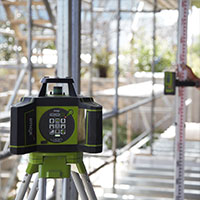
For the ‘all singing and dancing’ solution, it’s clear to see that the i88R red beam and i88G green beam lasers tick the most boxes when it comes to features and benefits as well as application compatibility. For external tasks, it doesn’t matter whether you use the red or green version, as the laser will not be visible in daylight conditions, and accuracy when using with a receiver is not compromised in any way with different colours of laser. If a large proportion of your work is inside, the i88G would be a wise choice, but if it’s predominantly outside – the i88R is perfectly adequate.
For a budget solution, Imex also offer an entry-level construction laser – the E60 Rotating Construction Laser Kit. Although it’s comparable to the i66R in terms of range, accuracy and features – the IP rating is only IP54 and it’s powered by four traditional AA alkaline batteries. For the ‘odd-job’ it may be a solution, but there’s a possibility of fairly regular use – go for one of the i-Series units… you won’t be disappointed.

Joint Managing Director, Protrade
Craig has over 30 years of experience at Protrade, working in various departments including sales, procurement, and marketing, and ultimately becoming Managing Director in 2008. Following the merger of Protrade and Joinery Fit-Out Supplies in 2018, Craig is now the joint MD of the company.

